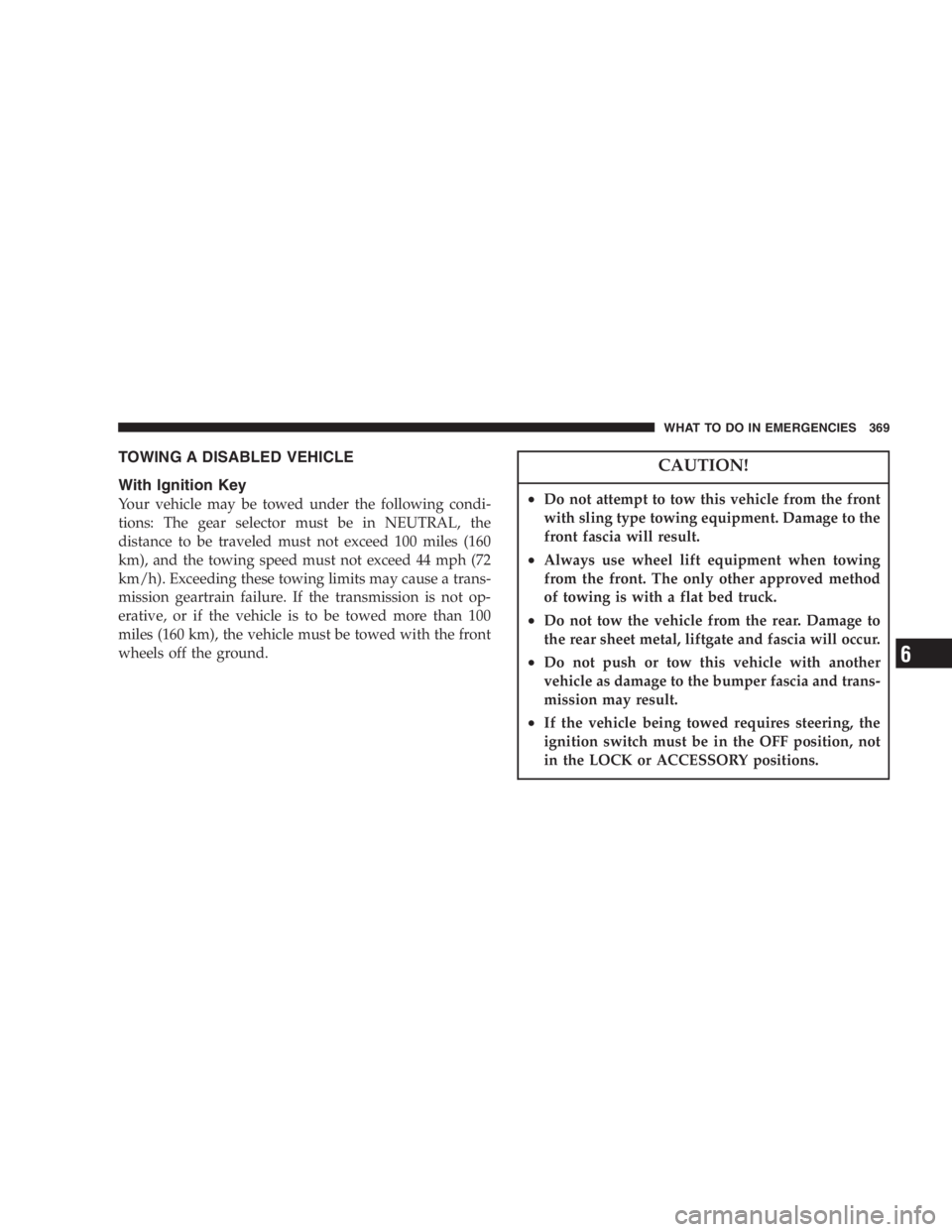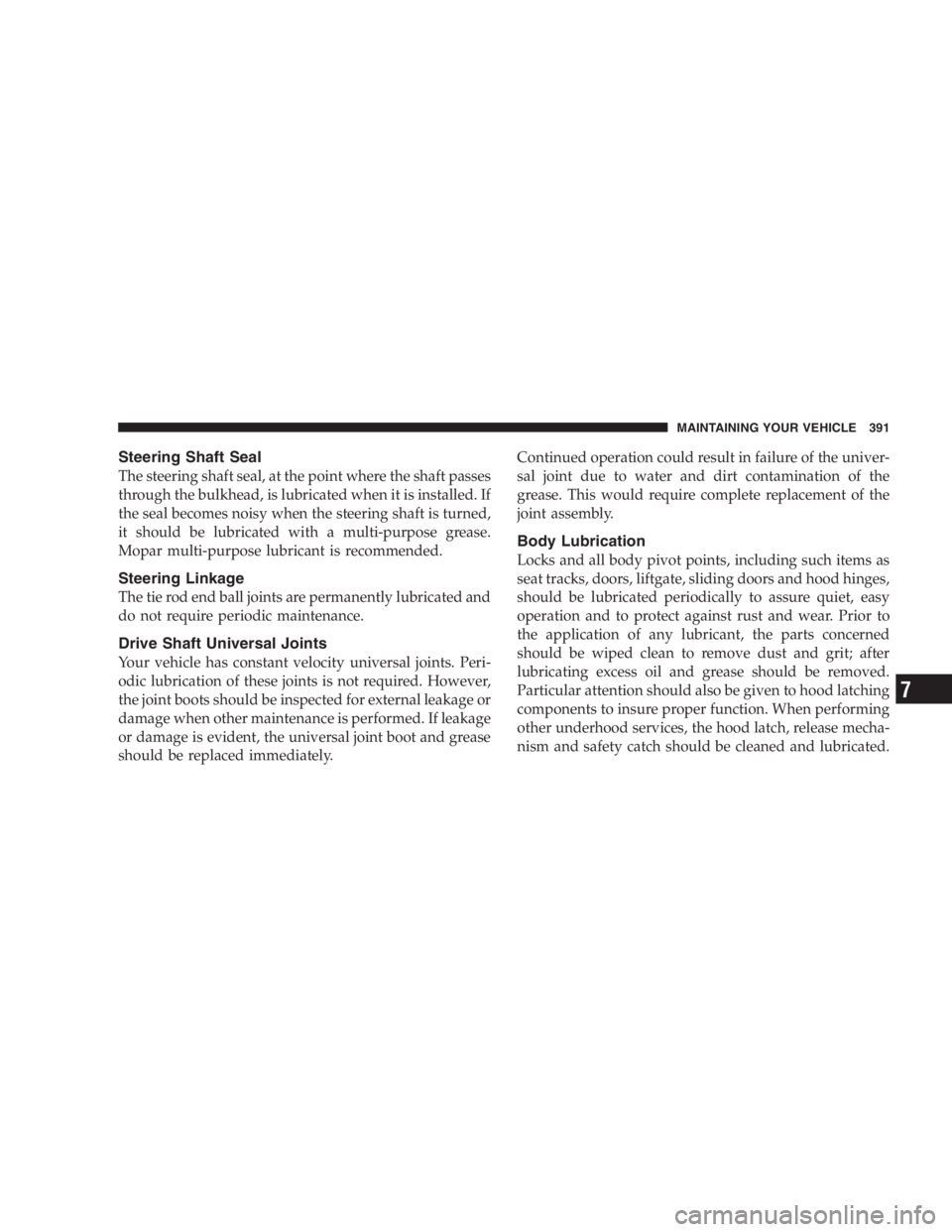Page 369 of 480

TOWING A DISABLED VEHICLE
With Ignition Key
Your vehicle may be towed under the following condi-
tions: The gear selector must be in NEUTRAL, the
distance to be traveled must not exceed 100 miles (160
km), and the towing speed must not exceed 44 mph (72
km/h). Exceeding these towing limits may cause a trans-
mission geartrain failure. If the transmission is not op-
erative, or if the vehicle is to be towed more than 100
miles (160 km), the vehicle must be towed with the front
wheels off the ground. CAUTION!• Do not attempt to tow this vehicle from the front
with sling type towing equipment. Damage to the
front fascia will result.
• Always use wheel lift equipment when towing
from the front. The only other approved method
of towing is with a flat bed truck.
• Do not tow the vehicle from the rear. Damage to
the rear sheet metal, liftgate and fascia will occur.
• Do not push or tow this vehicle with another
vehicle as damage to the bumper fascia and trans-
mission may result.
• If the vehicle being towed requires steering, the
ignition switch must be in the OFF position, not
in the LOCK or ACCESSORY positions. WHAT TO DO IN EMERGENCIES 369
6
Page 371 of 480
MAINTAINING YOUR VEHICLECONTENTS � 2.4L Engine ...........................374
� 3.3L/3.8L Engines ......................375
� Onboard Diagnostic System — OBDII........376
� Emissions Inspection And
Maintenance Programs ...................377
� Replacement Parts ......................378
� Dealer Service .........................378
� Maintenance Procedures ..................379
▫ Engine Oil ..........................379 ▫ Engine Oil Filter ......................383
▫ Drive Belts — Check Condition And Tension . . 383
▫ Spark Plugs .........................384
▫ Engine Air Cleaner Filter ................384
▫ Catalytic Converter ....................385
▫ Maintenance-Free Battery ................387
▫ Air Conditioner Maintenance .............388
▫ Power Steering — Fluid Check ............390
▫ Front Suspension Ball Joints ..............390
7
Page 372 of 480

▫ Steering Shaft Seal ....................391
▫ Steering Linkage ......................391
▫ Drive Shaft Universal Joints ..............391
▫ Body Lubrication .....................391
▫ Windshield Wiper Blades ................392
▫ Windshield And Rear Window Washers .....392
▫ Exhaust System ......................393
▫ Cooling System .......................394
▫ Hoses And Vacuum/Vapor Harnesses .......399
▫ Brakes .............................399
▫ Master Cylinder — ABS Brakes Brake
Fluid Level Check .....................401
▫ Fuel System Hoses ....................402 ▫ Automatic Transmission ................402
▫ Front And Rear Wheel Bearings ...........406
▫ Appearance Care And Protection
From Corrosion ......................406
▫ Cleaning The Instrument Panel And Underseat
Cup Holders ........................410
� Integrated Power Module (IPM) ............412
� Vehicle Storage ........................415
� Replacement Light Bulbs .................415
� Bulb Replacement ......................416
▫ Headlights ..........................416
▫ Front Park/Turn Signal And
Sidemarker Lights .....................418
▫ Front Fog Light ......................419372 MAINTAINING YOUR VEHICLE
Page 390 of 480

frame with the direction of airflow (away from the
blower motor and towards the center of the car).
Refer to the “ Maintenance Schedules ” section of this
manual for the recommended air conditioning filter
replacement intervals.
Power Steering — Fluid Check
Checking the power steering fluid level at a defined
service interval is not required. The fluid should only be
checked if a leak is suspected, abnormal noises are
apparent, and/or the system is not functioning as antici-
pated. Coordinate inspection efforts through a certified
DaimlerChrysler Dealership. � WARNING!Fluid level should be checked on a level surface and
with the engine off to prevent injury from moving
parts and to insure accurate fluid level reading. Do
not overfill. Use only manufacturers recommended
power steering fluid.
If necessary, add fluid to restore to the proper indicated
level. With a clean cloth, wipe any spilled fluid from all
surfaces. Refer to Recommended Fluids, Lubricants, and
Genuine Parts for correct fluid type.
Front Suspension Ball Joints
The front suspension ball joints are permanently sealed.
No regular maintenance is required for these compo-
nents.390 MAINTAINING YOUR VEHICLE
Page 391 of 480

Steering Shaft Seal
The steering shaft seal, at the point where the shaft passes
through the bulkhead, is lubricated when it is installed. If
the seal becomes noisy when the steering shaft is turned,
it should be lubricated with a multi-purpose grease.
Mopar multi-purpose lubricant is recommended.
Steering Linkage
The tie rod end ball joints are permanently lubricated and
do not require periodic maintenance.
Drive Shaft Universal Joints
Your vehicle has constant velocity universal joints. Peri-
odic lubrication of these joints is not required. However,
the joint boots should be inspected for external leakage or
damage when other maintenance is performed. If leakage
or damage is evident, the universal joint boot and grease
should be replaced immediately. Continued operation could result in failure of the univer-
sal joint due to water and dirt contamination of the
grease. This would require complete replacement of the
joint assembly.
Body Lubrication
Locks and all body pivot points, including such items as
seat tracks, doors, liftgate, sliding doors and hood hinges,
should be lubricated periodically to assure quiet, easy
operation and to protect against rust and wear. Prior to
the application of any lubricant, the parts concerned
should be wiped clean to remove dust and grit; after
lubricating excess oil and grease should be removed.
Particular attention should also be given to hood latching
components to insure proper function. When performing
other underhood services, the hood latch, release mecha-
nism and safety catch should be cleaned and lubricated. MAINTAINING YOUR VEHICLE 391
7
Page 400 of 480

WARNING!Riding the brakes can lead to brake failure and
possibly an accident. Driving with your foot resting
or riding on the brake pedal can result in abnormally
high brake temperatures, excessive lining wear, and
possible brake damage. You wouldn ’ t have your full
braking capacity in an emergency.
Brake And Power Steering Hoses
When the vehicle is serviced for scheduled maintenance,
inspect surface of hoses and nylon tubing for evidence of
heat and mechanical damage. Hard and brittle rubber,
cracking, tears, cuts, abrasion, and excessive swelling
indicate deterioration of the rubber. Particular attention
should be made to examining those hose surfaces nearest
to high heat sources, such as the exhaust manifold. Insure nylon tubing in these areas has not melted or
collapsed.
Inspect all hose connections such as clamps and cou-
plings to make sure they are secure and no leaks are
present.
NOTE: Often, fluid such as oil, power steering fluid,
and brake fluid are used during assembly plant opera-
tions to facilitate the assembly of hoses to couplings.
Therefore, oil wetness at the hose-coupling area is not
necessarily an indication of leakage. Actual dripping of
hot fluid when systems are under pressure (during
vehicle operation), should be noted before hose is re-
placed based on leakage.
NOTE: Inspection of brake hoses should be performed
whenever the brake system is serviced and every engine
oil change. Inspect hydraulic brake hoses for surface
cracking, scuffing, or worn spots. If there is any evidence
of cracking, scuffing, or worn spots, the hose should be400 MAINTAINING YOUR VEHICLE
Page 415 of 480

The Heated Mirrors, Lower Instrument Panel Power
Outlet and Removable Floor Console, when in the front
position are fused with self resetting fuses that are only
serviceable by an authorized dealer. The power seats are
fused by a 30 Amp circuit breaker located under the
driver ’ s seat. The Power Windows are fused by a 25 Amp
circuit breaker located under the instrument panel near
the steering column. If you experience temporary or
permanent loss of these systems see your authorized
dealer for service.
VEHICLE STORAGE
If you are leaving your vehicle dormant for more than 21
days you may want to take steps to protect your battery.
You may:
• Remove the 20 Amp mini fuse in the Integrated Power
Module labeled Ignition-Off Draw (IOD).
• Or, disconnect the negative cable from the battery. • Anytime you store your vehicle, or keep it out of
service (i.e. vacation) for two weeks or more, run the
air conditioning system at idle for about five minutes
in the fresh air and high blower setting. This will
insure adequate system lubrication to minimize the
possibility of compressor damage when the system is
started again.
REPLACEMENT LIGHT BULBS
LIGHT BULBS — Interior Bulb Number
Center & Rear Dome Light .................. 578
Center & Rear Reading Lights ............... 578
Front Door Courtesy Light .................. 578
Front Header Reading Lights — If Equipped ..... 578
Instrument Cluster Lights ................. PC74
Liftgate Light(s) .......................... 578
Overhead Console Reading Lights .......... PC579
Removable Console Light — If Equipped ....... 194
Visor Vanity Lights .................... 6501966MAINTAINING YOUR VEHICLE 415
7
Page 423 of 480
Chassis
Component Fluids, Lubricants and Genuine Parts.
Automatic Transmission Mopar � ATF+4 Automatic Transmission Fluid.
Brake Master Cylinder Mopar � DOT 3, SAE J1703 should be used. If DOT 3, SAE J1703 brake
fluid is not available, then DOT 4 is acceptable. Use only recommended
brake fluids.
Power Steering Reservoir Mopar � ATF+4 Automatic Transmission Fluid. MAINTAINING YOUR VEHICLE 423
7